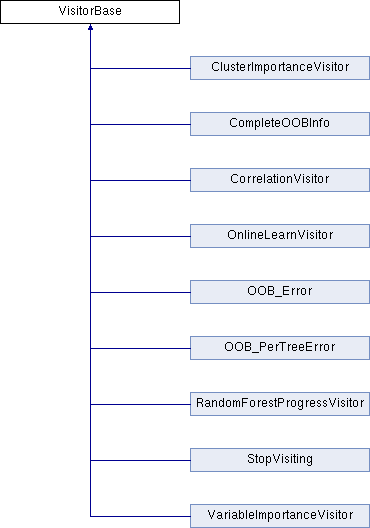
|
VisitorBase Class Reference |  |
#include <vigra/random_forest/rf_visitors.hxx>

Public Member Functions | |
| double | return_val () |
| template<class Tree , class Split , class Region , class Feature_t , class Label_t > | |
| void | visit_after_split (Tree &tree, Split &split, Region &parent, Region &leftChild, Region &rightChild, Feature_t &features, Label_t &labels) |
| template<class RF , class PR , class SM , class ST > | |
| void | visit_after_tree (RF &rf, PR &pr, SM &sm, ST &st, int index) |
| template<class RF , class PR > | |
| void | visit_at_beginning (RF const &rf, PR const &pr) |
| template<class RF , class PR > | |
| void | visit_at_end (RF const &rf, PR const &pr) |
| template<class TR , class IntT , class TopT , class Feat > | |
| void | visit_external_node (TR &tr, IntT index, TopT node_t, Feat &features) |
| template<class TR , class IntT , class TopT , class Feat > | |
| void | visit_internal_node (TR &, IntT, TopT, Feat &) |
Detailed Description
Base Class from which all Visitors derive. Can be used as a template to create new Visitors.
Member Function Documentation
| void visit_after_split | ( | Tree & | tree, |
| Split & | split, | ||
| Region & | parent, | ||
| Region & | leftChild, | ||
| Region & | rightChild, | ||
| Feature_t & | features, | ||
| Label_t & | labels | ||
| ) |
do something after the the Split has decided how to process the Region (Stack entry)
- Parameters
-
tree reference to the tree that is currently being learned split reference to the split object parent current stack entry which was used to decide the split leftChild left stack entry that will be pushed rightChild right stack entry that will be pushed. features features matrix labels label matrix
- See Also
- RF_Traits::StackEntry_t
| void visit_after_tree | ( | RF & | rf, |
| PR & | pr, | ||
| SM & | sm, | ||
| ST & | st, | ||
| int | index | ||
| ) |
do something after each tree has been learned
- Parameters
-
rf reference to the random forest object that called this visitor pr reference to the preprocessor that processed the input sm reference to the sampler object st reference to the first stack entry index index of current tree
| void visit_at_end | ( | RF const & | rf, |
| PR const & | pr | ||
| ) |
do something after all trees have been learned
- Parameters
-
rf reference to the random forest object that called this visitor pr reference to the preprocessor that processed the input
| void visit_at_beginning | ( | RF const & | rf, |
| PR const & | pr | ||
| ) |
do something before learning starts
- Parameters
-
rf reference to the random forest object that called this visitor pr reference to the Processor class used.
| void visit_external_node | ( | TR & | tr, |
| IntT | index, | ||
| TopT | node_t, | ||
| Feat & | features | ||
| ) |
do some thing while traversing tree after it has been learned (external nodes)
- Parameters
-
tr reference to the tree object that called this visitor index index in the topology_ array we currently are at node_t type of node we have (will be e_.... - ) features feature matrix
- See Also
- NodeTags;
you can create the node by using a switch on node_tag and using the corresponding Node objects. Or - if you do not care about the type use the NodeBase class.
| void visit_internal_node | ( | TR & | , |
| IntT | , | ||
| TopT | , | ||
| Feat & | |||
| ) |
do something when visiting a internal node after it has been learned
- See Also
- visit_external_node
| double return_val | ( | ) |
return a double value. The value of the first visitor encountered that has a return value is returned with the RandomForest::learn() method - or -1.0 if no return value visitor existed. This functionality basically only exists so that the OOB - visitor can return the oob error rate like in the old version of the random forest.
The documentation for this class was generated from the following file:
- vigra/random_forest/rf_visitors.hxx